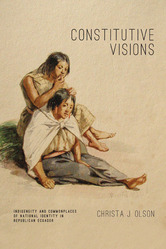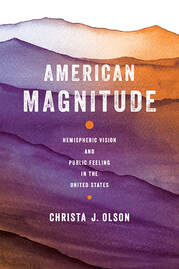I study the rhetorical history of the Americas with a particular focus on visual culture. My first book, Constitutive Visions: Indigeneity and Commonplaces of National Identity in Republican Ecuador, illuminates the crucial roles that images of indigenous people played in the development of national identity in Ecuador during the nineteenth and twentieth centuries. My second book, American Magnitude: Hemispheric Vision and Public Feeling in the United States examines the visual history of U.S.-Latin American relations in order to understand how U.S. publics came to see themselves as particularly American among Americans. I am co-author, with Brandee Easter, of the forthcoming digital book On Visual Rhetoric. I have also written about casta painting in eighteenth century New Spain and appeals to "Américan" regionalism by mid-twentieth century Latin American intellectuals. In addition to writing rhetorical histories, I have published several articles about research methods and edited a special issue of Advances in the History of Rhetoric on the future of historical research in rhetorical studies. My newest work is headed in two directions: a general interest project on visual ethics and a collaborative project on place, public memory, and prisons in Wisconsin.
To see a full list of my publications, download my CV.
To see a full list of my publications, download my CV.

Constitutive Visions: Indigeneity and Commonplaces of National Identity in Republican Ecuador, traces the repeated arguments over national identity that punctuate the rhetorical history of Ecuador during the nineteenth and twentieth centuries. Arguing that images of indigenous people haunt Ecuador's long process of national identity formation, the book tracks such images across paintings and photographs, public speeches and municipal documents, newspaper articles and scholarly books. It reveals that even as indigenous people were systematically excluded from civic life in Ecuador, images of them proliferated and served crucial civic functions. Constitutive Visions places petitions from indigenous laborers alongside oil paintings hung in private collections, overlays woodblock illustrations with legislative debates, and analyzes Ecuador's nineteen constitutions in light of the national landscape. Ultimately, the book uses those juxtapositions to make sense of the contradictions that sustain and unsettle the postcolonial nation-state.

At a moment in US politics when racially motivated nationalism, shifting relations with Latin America, and anxiety over national futures intertwine, understanding the long history of American preoccupation with magnitude and how it underpins national identity is vitally important. In American Magnitude, Christa J. Olson tracks the visual history of US appeals to grandeur, import, and consequence (megethos), focusing on images that use the wider Americas to establish US character. Her sources—including lithographs from the USMexican War, pre–Civil War paintings of the Andes, photo essays of Machu Picchu, and WWII-era films promoting hemispheric unity—span from 1845 to 1950 but resonate into the present.
Olson demonstrates how those crafting the appeals that feed the US national imaginary—artists, scientists, journalists, diplomats, and others—have invited US audiences to view Latin America as a foil for the greatness of their own nation and encouraged white US publics in particular to see themselves as especially American among Americans. She reveals how each instance of visual rhetoric relies upon the eyes of others to instantiate its magnitude—and falters as some viewers look askance instead. The result is the possibility of a post-magnitude United States: neither great nor failed, but modest, partial, and imperfect.
Olson demonstrates how those crafting the appeals that feed the US national imaginary—artists, scientists, journalists, diplomats, and others—have invited US audiences to view Latin America as a foil for the greatness of their own nation and encouraged white US publics in particular to see themselves as especially American among Americans. She reveals how each instance of visual rhetoric relies upon the eyes of others to instantiate its magnitude—and falters as some viewers look askance instead. The result is the possibility of a post-magnitude United States: neither great nor failed, but modest, partial, and imperfect.
Proudly powered by Weebly